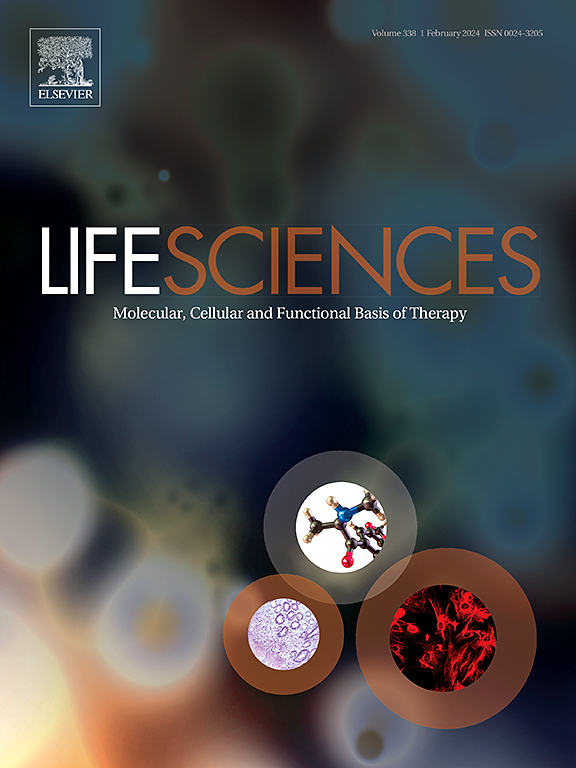达格列净通过NRF2蛋白上调驱动谷胱甘肽合成抑制心肌铁下垂来减轻糖尿病心肌病
IF 5.1
2区 医学
Q1 MEDICINE, RESEARCH & EXPERIMENTAL
引用次数: 0
摘要
目的:铁下垂已成为促进2型糖尿病性心肌病(DCM)发生和发展的关键病理机制。Dapagliflozin (DAPA)是一种钠-葡萄糖共转运蛋白2抑制剂(SGLT2i),具有确定的心血管益处,然而,DAPA在2型DCM期间调节铁死亡的功效仍有待阐明。在体内,研究人员使用自发性糖尿病大鼠GK模型进行了蛋白质组学分析,揭示了正常对照组、GK组和GK + DAPA组中与谷胱甘肽代谢失调相关的不同心肌铁凋亡特征。随后的验证证实了糖尿病心肌中的特征性铁下沉标志物,包括铁2+水平升高,铁3+沉积增加,丙二醛(MDA)介导的脂质过氧化升高,以及超微结构线粒体畸变。DAPA (5 mg/kg/d)可显著恢复谷胱甘肽稳态,减轻心肌铁下垂和重构,增强心功能。这种效应与铁下垂调节因子NRF2、SLC7A11、GPX4和FTH-1蛋白表达上调有关。心肌细胞特异性aav9介导的Nrf2过表达和药物干预(erastin/ferrostatin-1)发现Nrf2是DAPA抗趋铁作用的关键介质。值得注意的是,DAPA挽救了erastin诱导的DCM铁下垂。在体外,使用高糖刺激的H9C2心肌细胞进行验证,复制了铁致凋亡表型,显示铁过载,MDA和脂质ROS升高,以及线粒体消耗。基因Nrf2沉默、基因Gpx4沉默或erastin处理加剧了这些影响,而DAPA (10μM)和ferrostatin-1 (10μM)均表现出相当的铁死亡抑制作用。意义:apa通过NRF2蛋白上调驱动谷胱甘肽合成抑制2型DCM心肌铁下垂,确定NRF2上调作为2型DCM铁下垂干预的有希望的治疗靶点。本文章由计算机程序翻译,如有差异,请以英文原文为准。

Dapagliflozin attenuates diabetic cardiomyopathy via NRF2 protein upregulation-driven glutathione synthesis to inhibit myocardial ferroptosis
Aims
Ferroptosis has emerged as a critical pathological mechanism contributing to the development and progression of type 2 diabetic cardiomyopathy (DCM). Dapagliflozin (DAPA), a sodium-glucose co-transporter 2 inhibitor (SGLT2i) with established cardiovascular benefits, however, DAPA's efficacy in modulating ferroptosis during type 2 DCM remains to be elucidated.
Methods and fundings
In vivo, using a spontaneously diabetic Goto-Kakizaki (GK) rat model, we conducted proteomic profiling revealing distinct myocardial ferroptosis signatures associated with dysregulated glutathione metabolism across normal control, GK and GK + DAPA groups. Subsequent validation demonstrated characteristic ferroptosis markers in diabetic myocardium, including elevated Fe2+ level, increased Fe3+ deposition, heightened malondialdehyde (MDA)-mediated lipid peroxidation, and ultrastructural mitochondrial aberrations. DAPA administration (5 mg/kg/d) significantly restored glutathione homeostasis, mitigated myocardial ferroptosis and remodeling and enhanced cardiac function. This effect correlated with upregulated expression of ferroptosis regulators: NRF2, SLC7A11, GPX4 and FTH-1 proteins. Cardiomyocyte-specific AAV9-mediated Nrf2 overexpression and pharmacological interventions (erastin/ferrostatin-1) identified NRF2 as the key mediator of DAPA's anti-ferroptotic action. Notably, DAPA rescued erastin-induced ferroptosis in DCM. In vitro, validation using high glucose-stimulated H9C2 cardiomyocytes replicated the ferroptotic phenotype, showing iron overload, MDA and lipid ROS elevation, and mitochondrial depletion. Genetic Nrf2 silencing, genetic Gpx4 silencing or erastin treatment exacerbated these effects, while both DAPA (10μM) and ferrostatin-1 (10 μM) demonstrated comparable ferroptosis inhibition.
Significance
DAPA attenuates type 2 DCM via NRF2 protein upregulation-driven glutathione synthesis to inhibit myocardial ferroptosis, identifying upregulation of NRF2 as a promising therapeutic target for ferroptosis intervention in type 2 DCM.
求助全文
通过发布文献求助,成功后即可免费获取论文全文。
去求助
来源期刊

Life sciences
医学-药学
CiteScore
12.20
自引率
1.60%
发文量
841
审稿时长
6 months
期刊介绍:
Life Sciences is an international journal publishing articles that emphasize the molecular, cellular, and functional basis of therapy. The journal emphasizes the understanding of mechanism that is relevant to all aspects of human disease and translation to patients. All articles are rigorously reviewed.
The Journal favors publication of full-length papers where modern scientific technologies are used to explain molecular, cellular and physiological mechanisms. Articles that merely report observations are rarely accepted. Recommendations from the Declaration of Helsinki or NIH guidelines for care and use of laboratory animals must be adhered to. Articles should be written at a level accessible to readers who are non-specialists in the topic of the article themselves, but who are interested in the research. The Journal welcomes reviews on topics of wide interest to investigators in the life sciences. We particularly encourage submission of brief, focused reviews containing high-quality artwork and require the use of mechanistic summary diagrams.
 求助内容:
求助内容: 应助结果提醒方式:
应助结果提醒方式:


